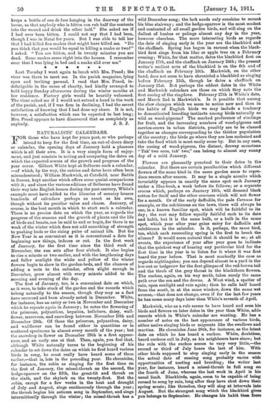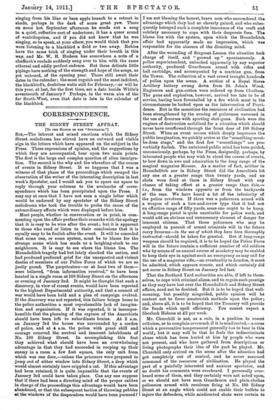NATURALISTS' CALENDARS.
'FOR those who have kept for years past, or who perhaps intend to keep for the first time, an out-of-doors diary or calendar, the opening days of January hold a pleasure which is all their own. It is a very simple form of enjoy- ment, and just consists in noting and comparing the dates on which the expected events of the growth and progress of the year occur. Gilbert White kept at Selborne such a calendar, —of which, by the way, the entries and dates have often been misunderstood ; William Mark wick, at Catsfield, near Battle in Sussex, kept another which offers some quaint comparisons with it; and since the various editions of Selborne have found their way into English homes during the past century, White's example must have added to the libraries of country houses hundreds of calendars perhaps as exact as his own, though without its peculiar value and charm. January, of course, is the best month in which to start such a calendar. There is no precise date on which the year, as regards the progress of the seasons and the growth of plants and the life of birds and beasts, can be said to end or begin, for there is no week of the winter which does not add something of strength to pushing buds or the rising pulse of animal life. But the New Year is as convenient as it is conventional a date for beginning new things, indoors or out. In the first week of January, for the first time since the third week of November, the sun sets after four o'clock. It also begins to rise a minute or two earlier, and with the lengthening days and fuller sunlight the white and yellow of the winter flowers begin to show in the garden-beds, and the chances of adding a note to the calendar, often slight enough in December, grow almost with every minute added to the morning and evening of the day.
The first of January, too, is a convenient date on which, as it were, to take stock of the garden and the records which belong naturally to the season, though they may as a fact have occurred and been already noted in December. White, for instance, has an entry or two in November and December which be repeats again in January ; he notes the flowering of the primrose, polyanthus, hepatica, hellebore, daisy, wall- flower, mezereon, and snowdrop between November 10th and December 29th. Of these the primrose, polyanthus, daisy, and wallflower can be found either in quantities or in scattered specimens in almost every mouth of the year ; but the snowdrop in flower on December 29th is a first appear- ance, and an early one at that. Then, again, you feel that, although White naturally turns to the beginning of his calendar to set down the dates on which be first heard various birds in song, he must really have heard some of them earlier,—that ia, late in the preceding year. He chronicles, for instance, the robin as singing for the first time on the first of January, the missel-thrush on the second, the hedge-sparrow on the fifth, the great-tit and thrush on the sixth, and the skylark on the twenty-first. But the robin, except for a few weeks in the heat and drought of July and August, sings continuously through the year ; the thrush begins his autumn song in September, and sings intermittently through the winter; the missel-thrush has a
wild December song; the lark needs only sunshine to mount his blue stairway ; and the hedge-sparrow is the most modest and contented of all small garden birds, and will sing on the dullest of bushes or palings almost any day in the year, however cheerless. The more interesting birds as regards the date of singing early in the year are the blackbird and the chaffinch. Spring has begun in earnest when the black- bird first sings from his lilac or apple tree on a February evening ; White, for that matter, dates the blackbird first on January 17th, and the chaffinch on January 24th; the present writer's earliest note of the blackbird is on the 6th and of the chaffinch on February 10th. Markwick, on the other hand, does not seem to have chronicled a blackbird as singing before February 15th, though he dates a chaffinch on January 21st. But perhaps the oddest dates in the White and Markwick calendars are those on which they note the first cooing of the ringdove. February 27th is White's date, and March 2nd is Markwick's. Is it possible that among the slow changes which we seem to notice now and then in the habits of English birds we may include a tendency to domesticated breeding instincts among birds naturally so wild as wood-pigeons? The marked preference of starlings for fruit, and the increasing numbers of wood-pigeons and carrion-crows in urban districts, possibly are to be classed together as changes corresponding to the thicker population of the country; the birds go where they are less molested and take the food which is most easily come by. But in any case, the cooing of wood-pigeons, the distant, drowsy monotone " Tale two coos, tak' two," can belong to almost any sunny day of a mild January.
Flowers are pleasantly punctual to their dates in the calendar. But there are certain peculiarities which different flowers of the same kind in the same garden seem to repro- duce season after season. It may be a single aconite which invariably appears in exactly the same spot each January under a lilac-bush, a week before its fellows; or a separate crocus which, perhaps on January 16th, will demand black cotton for itself and the other crocuses which will not flower for a month. Or of the early daffodils, the pale Cerrtuus for example, or the colchicums on the lawn, there will always be one, in a known familiar spot, which will be faithful to its day; the rest may follow equally faithful each to its date and habit, but it is the same bulb, or a bulb in the same spot, which year after year gains entry for daffodils and colchicums in the calendar. Is it, perhaps, the same bird, too, which each succeeding spring is the first to break the silence ? It would seem natural that it should be so ; at all events, the experience of year after year goes to indicate that the quickest way of hearing any particular bird for the first time in the year is to listen for it where it was first heard the year before. That is most markedly the ease as regards nightingales; you can depend almost to a yard in the low-cut or hedgerow for the first glimpse of the red-brown tail and the throb of the grey throat in the blackthorn flowers. The cuckoo, again, on his way north, takes surely the same path over the sea and the downs. A West wind, a spatter of rain, open sunlight and rain again ; then he calls half heard from the south, in at the same window, down the same wet avenue,—that does not change, even if for the last few years he has come many days later than White's seventh of April.
Markwick, who as a rule seems to have heard and seen his birds and flowers on later dates in the year than White, adds records which in White's calendar are wanting. He has a number of notes on the last appearance of various birds, either native singing birds or migrants like the swallows and martins. He chronicles June 28th, for instance, as the latest date on which he has heard a cuckoo. White, doubtless, heard cuckoos call in July, as his neighbours have since; but the rule with the cuckoo seems to vary very little,—the second or third of July hears the last of him. With other birds supposed to stop singing early in the season the actual date of ceasing song probably varies with opportunities of nesting and breeding ; the writer last year, for instance, heard a missel-thrush in full song on the fourth of June, whereas the last week in April is his usual limit. Blackbirds, again, seem to be capable of being roused to song by rain, long after they have shut down their spring music; like thrushes, they will sing at intervals into August. But the strangest song which the blackbird gives you belongs to September. He changes his habit then from
singing from his lilac or bare apple branch to a retreat in shade, perhaps in the dark of some great yew. There on some hot September afternoon he sends out a song in a quiet, reflective sort of undertone; it has a queer sound of ventriloquism, and if you did not know that he was singing, so to speak, at your elbow, you would think that you were listening to a blackbird a field or two away. Robins have the same trick of singing under their breath in this way, and Mr. W. H. Hudson has somewhere a note of a chaffinch's roulade suddenly sung over to him with the same ethereal and oddly perfect cadence. But these delicate little pipings have nothing of the strength and hope of the songs, as yet unheard, of the opening year. Those still await their dates in the calendar; the most roguish and the most indolent, the blackbird's, doubtless waits still for February,—or will he this year, at last, for the first time, set a date beside White's seventeenth of January P Perhaps, in the warm airs of the far South-West, even that date is late in the calendar of the blackbird.







































 Previous page
Previous page